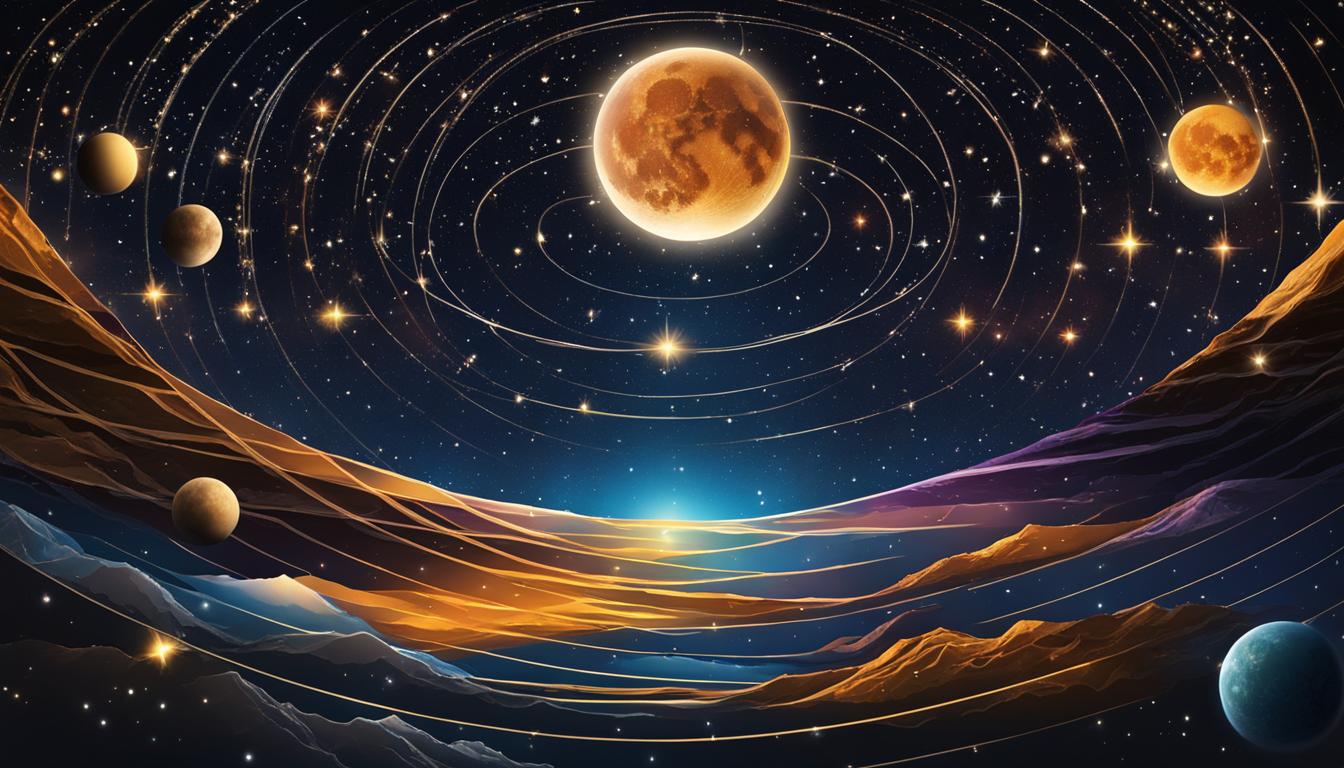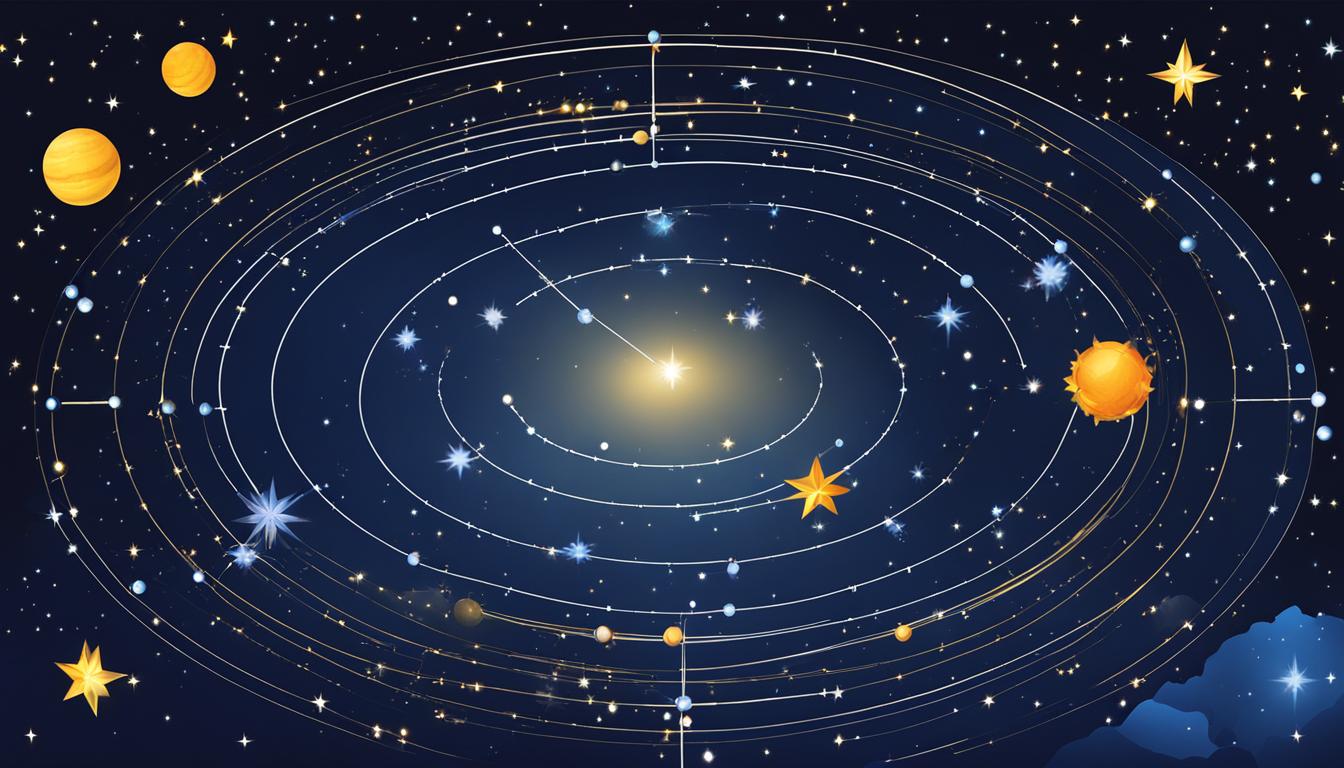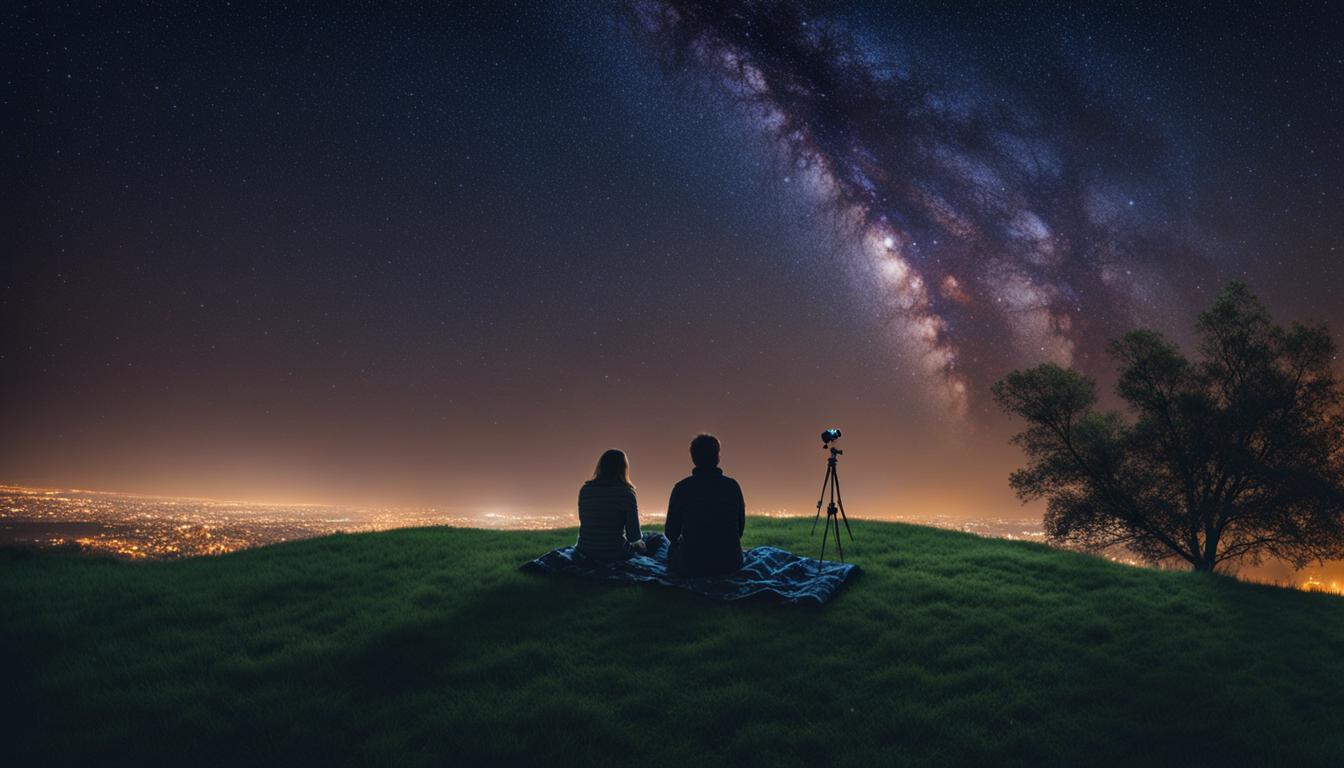Gazing at the stars has always been a source of wonder and inspiration. In this guide, we will provide beginners with all the tools and knowledge they need to explore the night sky. From finding the perfect stargazing spot to understanding the celestial calendar, decoding constellations, and even trying astrophotography, this guide will cover everything to make your stargazing experience out of this world.
Key Takeaways:
- Learn beginner stargazing tips and techniques to enhance your stargazing experience.
- Discover essential stargazing tools and the best telescopes for beginners.
- Find the perfect stargazing locations away from city lights for optimal visibility.
- Explore stargazing apps and guides to assist you in navigating the night sky.
- Engage in various stargazing activities like observing the moon, discovering planets, and capturing stunning astrophotography.
Finding the Perfect Spot: No, Your Couch Doesn’t Count!
When it comes to stargazing, finding the perfect location is key. Unfortunately, your cozy couch just won’t cut it. To truly enjoy the wonders of the night sky, you need to venture away from the bright lights of the city and find a spot with minimal light pollution. This means seeking out dark sky locations where the stars can shine in all their glory.
So where can you go to find the perfect stargazing spot? Look for parks, beaches, or even your own backyard, as long as you have a clear view of the sky. Remember, the darker the sky, the more stars you’ll be able to see. Spread out a blanket on the ground to make yourself comfortable, but be cautious of ants or nocturnal creatures that may share the space with you.
When choosing a location, it’s important to consider a few factors. Check the weather conditions to ensure clear skies. Consider the altitude and terrain of the area, as higher elevations can offer clearer views. Minimize any light sources, such as nearby buildings or streetlights, that could hinder your stargazing experience. And of course, always prioritize your safety when venturing out into the darkness of the night.
Gear Up: The Essential Tools for Stargazing Success
When it comes to stargazing, having the right equipment can greatly enhance your experience. While you can enjoy the beauty of the night sky with just your eyes, a few essential tools can take your stargazing to the next level.
- Binoculars for Stargazing: Consider investing in a pair of binoculars specifically designed for stargazing. They provide a wider field of view, allowing you to observe celestial objects in more detail.
- Telescopes for Beginners: If you’re looking to delve deeper into the cosmos, a telescope is a fantastic option. There are many telescopes available for beginners that are easy to set up and use.
- Stargazing Accessories: To make your stargazing experience comfortable and enjoyable, don’t forget to bring a few accessories. A star chart or smartphone app can help you identify constellations, while a red flashlight will preserve your night vision. It’s also a good idea to bring a blanket, warm clothing, snacks, and water.
While these tools are not necessary for stargazing, they can significantly enhance your ability to explore and appreciate the wonders of the night sky. Remember, the most important thing is to keep an open mind, be patient, and let the stars guide you on an unforgettable journey through the cosmos.
Understanding the Celestial Calendar: Timing is Everything
The celestial calendar is a crucial tool for any stargazer, guiding you on when to expect celestial events such as meteor showers, eclipses, and planet alignments. By understanding the timing of these events, you can plan your stargazing outings to ensure the best viewing experience possible.
One of the most anticipated celestial events are meteor showers, which occur when Earth passes through a trail of debris left by a comet. These showers can produce stunning displays of shooting stars and are best viewed during their peak activity. Consulting the celestial calendar will let you know when the next meteor shower is happening and help you plan your stargazing adventure accordingly.
Eclipses, both lunar and solar, are also highly anticipated astronomical events. Lunar eclipses occur when the Earth casts a shadow on the Moon, while solar eclipses happen when the Moon passes between the Earth and the Sun, momentarily blocking the Sun’s light. These events are rare and provide an excellent opportunity for stargazers to witness the beauty of celestial alignments. The celestial calendar will inform you about upcoming eclipses and their visibility in your location.
Additionally, the celestial calendar can help you track planet alignments, when multiple planets appear close together in the night sky. These alignments create stunning visual displays and allow stargazers to observe the planets in close proximity. By consulting the celestial calendar, you can identify when these alignments will occur and plan your stargazing outings accordingly.
Overall, the celestial calendar is an indispensable tool for stargazers. It allows you to stay informed about upcoming celestial events, ensuring that you don’t miss out on the best opportunities for stargazing. So grab your telescope or binoculars, consult the celestial calendar, and get ready to be amazed by the wonders of the night sky!

Decoding the Celestial Alphabet: Getting to Know the Constellations
One of the most fascinating aspects of stargazing is the opportunity to explore and identify constellations. Constellations are groups of stars that form recognizable patterns in the night sky. By decoding this celestial alphabet, you can navigate the vast expanse above and gain a deeper understanding of the cosmos.
The first step in identifying constellations is to familiarize yourself with star charts or smartphone apps specifically designed for stargazing. These tools provide detailed maps of the night sky, highlighting the positions and shapes of constellations. With a star chart in hand or an app at your fingertips, you can easily locate and identify the constellations visible from your viewing location.
To begin, focus on a few well-known constellations like Orion, Ursa Major (the Big Dipper), and Leo. These constellations are easily recognizable and serve as anchor points for navigating the night sky. Once you’ve become comfortable with these familiar patterns, you can expand your knowledge and explore additional constellations, gradually building your celestial repertoire.
Unlocking the Celestial Alphabet
Understanding the celestial alphabet is essential for navigating the night sky and identifying constellations. The celestial alphabet consists of stars that form the outline of each constellation. These stars serve as guideposts, allowing you to connect the dots and visualize the shape of each celestial pattern.
“The stars are like the letters of a great celestial alphabet, written across the night sky. Once you learn to read this celestial language, a whole new world of discovery unfolds before your eyes.”
By familiarizing yourself with the unique characteristics and narrative behind each constellation, you can deepen your appreciation for the rich history and mythology associated with the stars. Whether you’re tracing the mighty hunter Orion or following the story of Perseus and Andromeda, the constellations offer a captivating glimpse into ancient tales woven into the fabric of our universe.

Star-Hopping: The Art of Navigating the Night Sky
Once you have found the perfect spot for stargazing and have your essential tools ready, it’s time to dive into the fascinating technique of star-hopping. Star-hopping is a tried and true method used by astronomers to navigate the night sky and locate celestial objects. It involves using recognizable stars as stepping stones to guide you to your desired target.
To begin star-hopping, choose a bright star as your starting point. This star will serve as your reference point for navigation. From there, look for other stars in the vicinity and mentally connect them to create a pathway towards your intended destination. Following the pattern of connecting stars, you can easily locate constellations, planets, and other interesting celestial sights.
Star-hopping requires observation and practice, but with time, you will develop the ability to navigate the night sky with ease. It’s like connecting the dots in a vast cosmic puzzle. So, grab your star chart or use a stargazing app to identify the stars, trace their patterns, and embark on a thrilling journey through the cosmos.

Enhance Your Star-Hopping Experience:
- Download a stargazing app: With a stargazing app on your smartphone, you can have a portable guide to the night sky that will assist you in identifying stars and constellations.
- Learn the celestial alphabet: Familiarize yourself with the names and shapes of the constellations. This knowledge will make it easier for you to follow the starry pathways.
- Join a stargazing group: Connecting with fellow stargazers can enhance your star-hopping experience. You can exchange tips, share observations, and learn from experienced astronomers.
“Star-hopping is like connecting the dots in a vast cosmic puzzle.”
Whether you are searching for the Orion Nebula, tracking down the Andromeda Galaxy, or simply exploring the wonders of the night sky, star-hopping is an essential technique that will unlock the secrets of the cosmos. So, grab your binoculars or telescope, immerse yourself in the beauty of the stars, and embark on an awe-inspiring star-hopping adventure.
The Moon and Beyond: Discovering Planets, Nebulae, and Galaxies

While the moon is undoubtedly a captivating celestial object to observe, the night sky holds even more wonders waiting to be discovered. With the right tools and knowledge, you can explore planets, nebulae, and galaxies, immersing yourself in the vastness of the cosmos.
When it comes to observing the moon, all you need is your eyes or a small telescope to witness its ever-changing phases and surface features. As the moon waxes and wanes, you can marvel at its beauty and gain a deeper understanding of the lunar cycle.
But don’t stop there! Turn your gaze towards the planets of our solar system and unlock a whole new realm of exploration. With just a telescope, you can observe the gas giants Jupiter and Saturn, complete with their intricate rings and fascinating moons. Mars, with its rusty red hue, offers glimpses of its polar ice caps and even dust storms.
As you venture further into the night sky, you’ll encounter nebulae and galaxies, vast clouds of gas and dust, and magnificent clusters of stars. The Orion Nebula, located in the sword of the Orion constellation, is a spectacular sight to behold, with its vibrant colors and newborn stars. Andromeda Galaxy, our nearest galactic neighbor, unveils its grand spiral structure, spanning over 200,000 light-years.
Exploring the Cosmos
“Stargazing is like embarking on a cosmic adventure, with each observation revealing hidden treasures. From the moon to planets, nebulae, and galaxies, the universe is both vast and full of wonders.”
As you delve deeper into stargazing, remember to use appropriate magnification and filters to enhance your observations. Filters can help you bring out the intricate details of planetary features or isolate specific wavelengths emitted by nebulae. Keep track of celestial events and consult star charts or astronomy apps to pinpoint the best times and locations for observing these celestial objects.
The moon and beyond offer endless possibilities for stargazers. So grab your telescope, embrace the wonders of the universe, and embark on a journey through the cosmos.
Capturing the Cosmos: Astrophotography for Beginners
One of the most captivating aspects of stargazing is the opportunity to capture the beauty of the night sky through astrophotography. With today’s advanced technology, even beginners can delve into this mesmerizing world. Astrophotography allows you to immortalize celestial objects, from stars and constellations to meteor showers and even the Milky Way. It’s a way to share the wonders of the cosmos with others and create stunning visual memories of your stargazing adventures.
Getting started in astrophotography doesn’t have to be intimidating. With just a camera or even a smartphone, you can begin capturing the night sky. The key is to experiment and practice to find the techniques that work best for you. Long exposures are commonly used in astrophotography to capture the faint light from distant stars and galaxies. To achieve sharp images, it’s important to use a stable support such as a tripod to eliminate camera shake.
“Astrophotography is a blend of art and science, where patience and persistence are rewarded with breathtaking images of the cosmos.” – Astronomer Jane Smith
There are numerous online resources and tutorials available for beginners interested in astrophotography. These guides can provide insights into camera settings, post-processing techniques, and recommended equipment. Online communities and forums are also great places to connect with experienced astrophotographers who can offer guidance and share their knowledge.
Remember, astrophotography is about more than just the technical details. It’s a creative process that allows you to express your unique perspective of the night sky. So, grab your camera, find a dark sky location, and let the cosmos inspire your photographic journey!
Pros and Cons of Stargazing
Stargazing, the act of observing celestial objects in the night sky, offers a multitude of benefits. One of the key advantages is the sense of wonder and inspiration it provides. Gazing at the stars can evoke a sense of awe and remind us of the vastness and beauty of the universe. It can also be a peaceful and meditative activity, allowing us to relax and escape the stresses of everyday life.
Stargazing also offers educational opportunities. By exploring the night sky, we can learn about constellations, planets, and other celestial objects. It can spark curiosity and deepen our understanding of astronomy and the wonders of the cosmos. Additionally, stargazing can foster a connection with nature as we appreciate the natural beauty of the night sky.
However, stargazing does come with its own set of challenges. One of the main obstacles is light pollution, which can hinder visibility and make it difficult to see stars and other objects clearly. Weather conditions can also impact stargazing, as clouds and fog can obstruct the view. Additionally, stargazing equipment, such as telescopes and binoculars, can be costly, posing a financial barrier for some individuals. Lastly, the limited visibility of certain celestial events and the need to plan outings based on the celestial calendar can require patience and flexibility.
Despite these challenges, the benefits of stargazing outweigh the drawbacks. It offers a unique opportunity to connect with the wonders of the universe, gain knowledge, and find solace in the beauty of the night sky. By embracing the pros and being prepared for the challenges, stargazers can embark on a fulfilling and enriching journey through the cosmos.
Tips for a Successful Stargazing Experience
Embarking on a stargazing adventure can be an awe-inspiring experience, but to make the most of it, it’s important to keep a few tips in mind. Whether you’re a beginner or have some stargazing experience under your belt, these tips will help you enhance your journey through the cosmos.
- Dress appropriately: The nighttime temperatures can drop significantly, so layer up and wear warm clothing. Don’t forget to bring blankets or a sleeping bag to keep comfortable during the long stargazing sessions.
- Bring essential tools and equipment: While stargazing can be enjoyed with just your eyes, consider bringing binoculars or a telescope to get a closer look at celestial objects. A star chart or a stargazing app on your smartphone will help you identify constellations. And don’t forget to pack a red flashlight to preserve your night vision.
- Choose optimal viewing spots: Find a location away from city lights to minimize light pollution. Parks, beaches, or even your own backyard can be great options. Ensure that you have a clear and unobstructed view of the sky.
- Protect your night vision: Avoid looking at bright lights or using your phone too often during stargazing sessions, as it can disrupt your night vision. Allow your eyes to adapt to the darkness for better visibility of celestial objects.
Remember that stargazing is a patient and curious endeavor. Take your time to explore the night sky and embrace the beauty of the stars above. Enjoy the tranquility and wonder that comes with observing the universe, and create memories that will last a lifetime.

Best Stargazing and Astronomy Apps
Technology has made stargazing more accessible and enjoyable than ever before, thanks to a wide range of stargazing and astronomy apps. These apps provide a wealth of information and tools to enhance your stargazing experience. Whether you’re a beginner or a seasoned astronomer, these apps can help you navigate the night sky, identify stars and constellations, and even discover celestial events.
One popular stargazing app is SkySafari, which offers a comprehensive and interactive guide to the night sky. With its extensive database of stars, planets, and other celestial objects, SkySafari allows you to explore the universe in great detail. You can simulate the night sky at any location and time, track the movement of planets, and even view the sky in different wavelengths.
If you’re looking for a free option, Stellarium is an excellent choice. This open-source planetarium software provides a realistic and immersive view of the night sky. It offers a user-friendly interface and a vast catalog of stars, constellations, and satellites. Stellarium also includes a powerful search functionality, allowing you to easily locate specific objects in the sky.
Another noteworthy app is Clear Outside, which focuses on providing accurate weather forecasts for stargazers. This app helps you plan your stargazing sessions by providing detailed weather information, including cloud cover, wind speed, and humidity. Clear Outside also offers a light pollution map, helping you find the best dark sky locations for optimal stargazing conditions.
Unlock the Beauty of the Night Sky with Stargazing Apps
With these stargazing and astronomy apps, you can unlock the beauty of the night sky and expand your knowledge of the universe. Whether you’re stargazing from your backyard or exploring remote locations, these apps will be your trusted companions in unraveling the mysteries of the cosmos. Download them on your smartphone and embark on an extraordinary journey through the stars.
Conclusion
As we come to the end of this stargazing guide, we hope you are feeling inspired to embark on your own cosmic journey. Stargazing is a captivating and rewarding activity that allows us to connect with the vastness of the universe. By following the tips and techniques we’ve shared, you can make the most of your stargazing experience.
Remember to find dark sky locations away from city lights to enjoy the full spectacle of the stars. Equip yourself with essentials like binoculars or a telescope, star charts or smartphone apps, and a red flashlight to preserve your night vision. Plan your stargazing outings based on the celestial calendar to witness meteor showers, eclipses, and planet alignments.
Decoding the celestial alphabet and practicing star-hopping will help you navigate the night sky with ease, while exploring the moon, planets, nebulae, and galaxies will bring you closer to the wonders of the cosmos. And if you’re feeling creative, try your hand at astrophotography to capture the beauty of the night sky.
Stargazing is an activity that offers endless possibilities for discovery and wonder. So grab your tools, venture into the darkness, and let the stars guide you on a journey of awe and inspiration. The universe awaits!
FAQ
Can I go stargazing from my backyard?
Yes, you can stargaze from your backyard as long as you have a clear view of the sky and minimal light pollution.
Do I need any special equipment to go stargazing?
While you can stargaze with just your eyes, using tools like binoculars, a telescope, and a star chart or smartphone app can enhance your experience.
How can I find constellations in the night sky?
You can use star charts or smartphone apps to help you identify and locate constellations. Starting with a few well-known constellations like Orion, Ursa Major, and Leo is a good way to begin.
What is star-hopping?
Star-hopping is a technique that involves connecting stars to navigate the night sky and locate celestial objects, such as constellations and planets.
Can I observe planets and galaxies during stargazing?
Yes, you can observe planets such as Mars, Jupiter, and Saturn, as well as nebulae and galaxies like the Orion Nebula and the Andromeda Galaxy.
How can I get started in astrophotography?
To get started in astrophotography, you’ll need a camera or smartphone, a tripod for stability, and resources like tutorials, online communities, and apps to guide you.
What are the benefits of stargazing?
Stargazing can offer a sense of wonder and relaxation, a connection with nature, and educational opportunities.
What are the challenges of stargazing?
Some challenges of stargazing include weather dependency, light pollution, equipment costs, and limited visibility.
What should I bring for a successful stargazing experience?
It is recommended to bring warm clothing, a blanket, snacks, water, essential tools like a red flashlight and star chart or smartphone app, and optional tools like a camera and notebook for astrophotography and observation documentation.
Are there any stargazing apps available?
Yes, there are various stargazing and astronomy apps available that can provide information about celestial events, help identify stars and constellations, and offer guided tours of the night sky. Some popular apps include SkySafari, Stellarium, and Clear Outside.
Is stargazing suitable for beginners?
Absolutely! Stargazing is a captivating and rewarding activity that anyone, including beginners, can enjoy with the right tools, knowledge, and enthusiasm.


